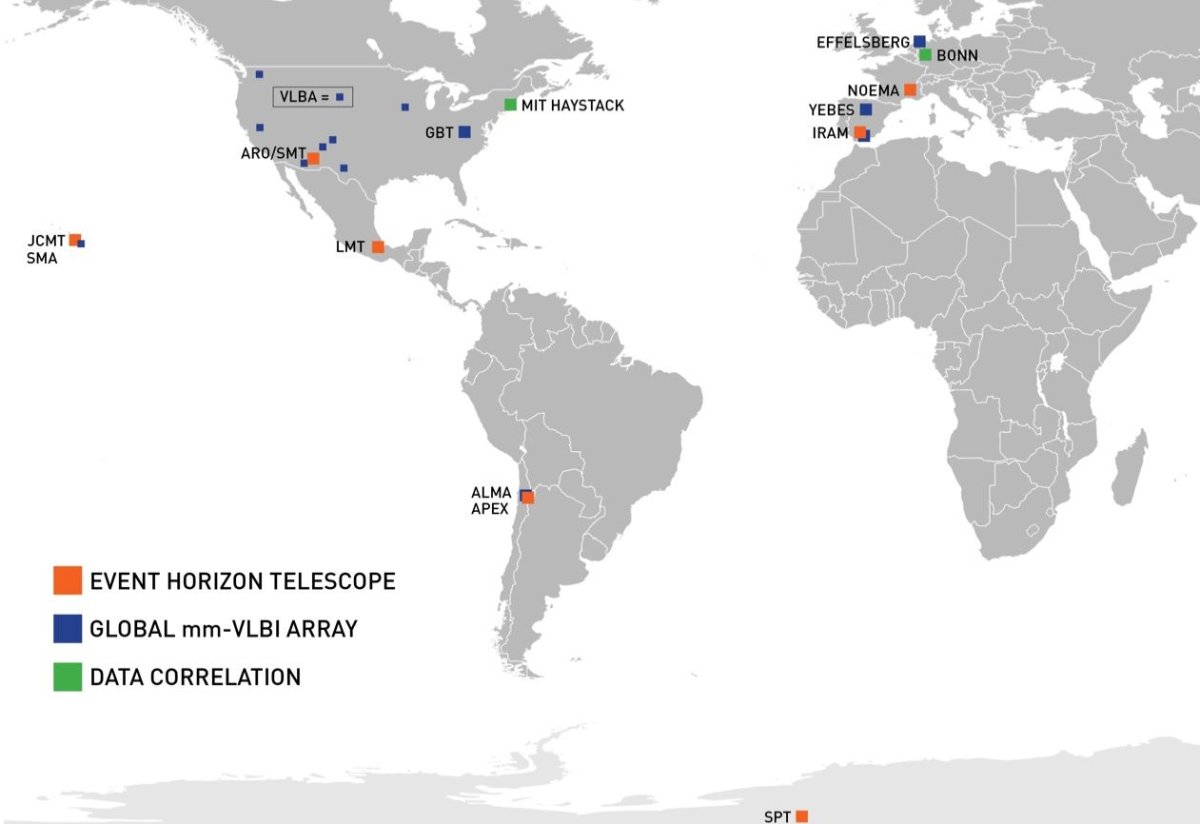
The first attempt to peer inside a black hole and take an image of its event horizon—the point of no return—appears to have been a success, with no major problems during the 10-day observation period. The mass of data collected is now being sent to two supercomputers in the US and Germany, and scientists expect to find out if they have the very first picture of a black hole in early 2018.
The Event Horizon Telescope is a hugely ambitious project. It links telescopes around the globe to create one Earth-sized telescope — these are connected virtually so it effectively has a diameter of the entire planet. This technique is not new, but this is the first time it has been done on such a large scale. The level of detail it provides is like being able to count the stitches on a baseball from 8,000 miles away.
Black holes are not hard to see. The material they accumulate is extremely hot, so very bright. The problem is the resolution of images returned—right now, they appear like a bright blur. The Event Horizon Telescope should be able to provide a clear image showing the ring surrounding a black hole and its shadow.
Researchers targeted two black holes. The first, Sagittarius A*, is the black hole that sits at the center of the Milky Way. The other, Messier 87, is a supermassive black hole in an elliptical galaxy 53 million light years away.
Vincent Fish, a research scientists at MIT Haystack, Massachusetts who is working on the project, tells Newsweek that the image returned should show the flow of material going in and out of the black hole. "What we expect to see is an asymmetric image where you have a circular dark region. That's the black hole shadow. And there might be a bright ring at the edge of that—which is the photon ring [a spherical region of space where gravity is so strong photons are forced to travel in orbits]. Then around it you will see one side is bright and the other side is faint, so kind of like a crescent.
"The reason for the crescent is that material near the black hole is moving at a few tenths of the speed of light. Special relativity tells you when particles emit photons—when they shine light at you—if the particles are moving towards you, it looks very bright, if they're moving away from you, then it gets very dim. That produces this asymmetry."
Processing the data
Around one petabyte of data has been collected. To put that into perspective, a petabyte of MP3 songs would play continuously for more than 2,000 years without repeating. Scientists are collecting and distributing the data between two research institutes: One at MIT Haystack, the other at the Max Planck Institute for Radio Astronomy in Bonn, Germany.
The data, recorded on hard disks, will be plugged into two correlators (or supercomputers). This will remove any time delays caused by the different global positioning of each telescope. "We plug it into the correlator and we look at each baseline to see if we detected anything. With the array we have, we should have plenty of sensitivity. If things went well, we should have clear detections on most of the baselines at least, but we won't know for certain until the data get back here," Fish says.
Data will come back in two waves. Most will be returned in the coming weeks, but what has been collected at the South Pole telescope will be unavailable for another six months— planes cannot land there because of winter, so at the moment, the data is "stranded," Fish explains.
Without this data, scientists cannot be sure of success. "I don't think we'll have the complete dataset until January next year. We'll have partial datasets in a couple of months and we'll look at the incomplete datasets just so we get a head start on data reduction and calibration so we know what issues there are and how to mitigate them," he says.
"We'll have a pretty good idea of whether it's been a success—how strongly we've detected sources—but for imaging the baselines to the South Pole are very important. So I think the imaging part can't really start in earnest until next year."

What does it all mean?
Black holes are effectively laboratories for extreme physics. Gravitational forces are so strong that nothing, not even light, can escape. An event horizon is the point of no return—it will drag in anything passing it. At the center of a black hole is what is known as a singularity: a one dimensional point that is unimaginably small, but contains a huge mass. At the singularity, spacetime curves infinitely and the laws of physics cease to exist.
"If you talk to people who study black holes, general relativity, thermodynamics and quantum mechanics, they will tell you one of these theories has to give at a black hole," Fish explains. An example of this is the information paradox. Put simply, quantum mechanics says information cannot truly be destroyed, so details of anything that is sucked into a black hole must remain in some way or form. General relativity, on the other hand, says nothing can survive a black hole.
"We have these assumptions about how the universe works, these well-tested theories, but at a black hole something is wrong and we don't know what it is," Fish says.
From the initial image returned, scientists should be able to test relativity. "If you know the mass of the black hole—and for Sagittarius A* we know that well—and if you know the distance of the black hole, which again we know well, then relativity predicts you will see that shadow and ring and that the ring will have a certain diameter and it will be near circular. That's a test of relativity. If the shape isn't circular or the wrong size, then relativity has made a prediction that has failed. That's the first thing we'll look at."

In the longer term, astrophysicists will be able to start studying exactly how material is sucked into a black hole and how it gets launched out into a jet. "It'll give us a better understanding of whether general relativity is an accurate description of the spacetime around a black hole," Fish says, adding it will be the first time we are able to test general relativity at the most extreme limits. "For general relativity, we've been assuming it's correct. There have been some tests of relativity in the weak field limit going back to 1919 with [Arthur] Eddington and the solar eclipse. But we haven't really been able to do any tests in the strong field limit. And there's really no stronger field than a black hole."
Astronomy research professor Gopal Narayanan, who led the efforts on the Event Horizon Telescope at the Large Millimeter Telescope in Mexico, said in a statement emailed to Newsweek: "[An event horizon] is the best lab we have to study the extreme physics out there. These are the observations that will help us to sort through all the wild theories about black holes. And there are many wild theories. With data from this project, we will understand things about black holes that we have never understood before."
Uncommon Knowledge
Newsweek is committed to challenging conventional wisdom and finding connections in the search for common ground.
Newsweek is committed to challenging conventional wisdom and finding connections in the search for common ground.
About the writer
Hannah Osborne is Nesweek's Science Editor, based in London, UK. Hannah joined Newsweek in 2017 from IBTimes UK. She is ... Read more
To read how Newsweek uses AI as a newsroom tool, Click here.








